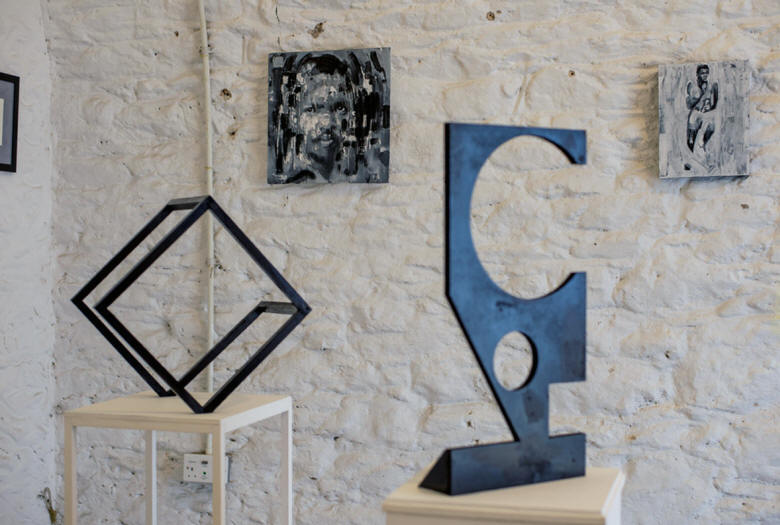|
|
| home | exhibitions | interviews | features | profiles | webprojects | archive |
|
Liam Symes and Paul Hillon: 'Gestalt' James McColl responds to an exhibition at The Pipe Gallery that was part of Plymouth Art Weekender September 2017
The eye is drawn immediately to one of Paul Hillon’s sculptures. It is a small, fragile-looking piece that snakes upwards. Individual blocks are still visible through the bold black paint, and each one forms a spine-shaped whole. Upon fully entering The Pipe, the eye is taken beyond the four artworks by Hillon, to Liam Symes’ work. For Gestalt, their first joint exhibition, Symes has paintings neatly arranged across two of the three walls. Grey and black smears of paint are spread across six canvases. Each lush brushstroke covers what resembles human body parts, and on further inspection, these fragmented pieces form figures and faces: a runner, a child whose teeth are being pulled, a naked woman, a medical practitioner being dressed. “Previously, the pieces that I’ve chosen for shows have been linked. There’s usually a theme involved as I usually work with a series of paintings... this isn’t random but it doesn’t have a direct natural theme” notes Symes. The idea that these styles could mesh seems far-fetched at first, yet the two are keen to make the distinction that Gestalt is a collaboration and not two artists simply sharing a space. In the middle of The Pipe, Hillon’s two sculptures dominate the remaining space. One, a cube-like shape, appears to be missing several sides, and another is a more delicate object from which a circular hole is cut. “One of the overarching principles [of Gestalt] is that when people view things, they view it as a whole and don’t recognise some of the parts that it takes to make the whole” notes Hillon. The loose concept of the Gestalt exhibition comes from its namesake German word Gestalt – which put simply, is to view something as a whole and not as a collection of parts. Hillon explains, “[Rudolf Arnheim] basically produced six principles on visual perception and the examples were actually black and white, and I just thought that was perfect for me to start thinking about what works I might make in terms of monochrome”. Though no obvious theme emerges at first glance, what inevitably pulls the monochrome exhibition together is its visual language and fractured shapes. Hillon’s geometrically perfect sculptures, that have been known to fill entire rooms, are not something that easily fit with paintings, Symes’ or otherwise. Similarly, Symes’ expressive and violent mark-making combined with his subject matter isolates his work. So, how do two artists like this, working in these mediums, come together?
One obvious upside to Gestalt is that Symes and Hillon have both scaled down their work. In Gestalt, both artists demonstrate vulnerability, perhaps because of their willingness to approach this exhibition differently. The frailty of Hillon’s work is unexpected, inviting scrutiny over detail rather than being in awe over an epic structure. The monochrome colour palette heightens this feeling of frailty in Symes work too. The bare flesh of the constrained figures creates stark images. This deliberate amputation and meticulous tonal brushwork help form dynamic shapes and images that intersect with Hillon’s sculptures. Their artistic experimentation in Gestalt is something that they are aware and weary of; “I’m not trying to get away from anything, [I] try and expand my repertoire... so I can respond to different situations”, argues Hillon. Symes adds “Myself and Paul, we are emerging artists, it’s early days yet… maybe I’ve stuck with the painting but I’m nowhere near the level I wish to be, I’m sure Paul feels the same [way]. It will always develop”. Much like Hillon’s sculptures that seem to have shapes cut out of them, the exhibition relies on seeing it as a whole, not a collection of parts. Though there is an obvious friction between the mediums, the two artists manage to create a dialogue that ultimately warrants the pairing and pushes each individual artist to reassess their approaches.
26/10/17 |
|
|

